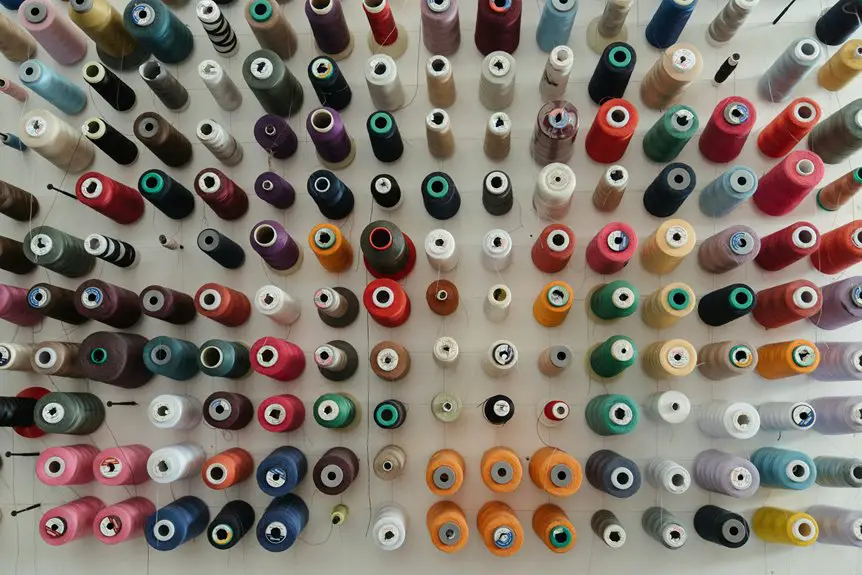It’s a funny coincidence that both acrylic and polyester often get lumped together as synthetic fabrics, yet they behave quite differently when it comes to breathability. If you’ve ever wondered why your acrylic sweater feels warmer but less comfortable during active days, or why polyester is a go-to for athletic wear, you’re not alone. Understanding which fabric traps heat and moisture more can change how you choose your clothes for comfort—so let’s explore what sets them apart.
Table of Contents
Key Takeaways
- Acrylic fibers are bulkier and trap more air, making acrylic generally less breathable than polyester.
- Polyester fabrics typically feature finer fibers and open weaves, enhancing airflow and breathability.
- Acrylic retains moisture longer and dries slower, reducing comfort and breathability in humid conditions.
- Polyester excels at moisture-wicking and quick drying, improving breathability during physical activity.
- Advanced polyester blends and fabric technologies further enhance breathability compared to standard acrylic fabrics.
Understanding Breathability in Synthetic Fabrics
Although synthetic fabrics like acrylic and polyester are popular for their durability, you might wonder how well they let your skin breathe.
Breathability depends largely on fabric structure, which determines how air moves through the material. When you wear a fabric with an open weave or knit, it promotes better airflow dynamics, allowing heat and moisture to escape.
Fabric structure governs breathability, with open weaves enhancing airflow to help heat and moisture escape.
On the other hand, tightly woven or dense fabrics restrict airflow, trapping sweat and heat close to your skin. Synthetic fibers often have smooth surfaces that can limit airflow compared to natural fibers.
Understanding these factors helps you choose fabrics that balance durability with comfort, especially if you’re active or in warm environments.
Comparative Breathability of Acrylic and Polyester
When you compare acrylic and polyester, you’ll notice they handle breathability differently due to their fiber structure and manufacturing processes.
Acrylic durability makes it a popular choice for warm clothing since its fibers trap air, providing excellent insulation.
Polyester texture, on the other hand, often feels smoother and less bulky, enhancing breathability in lighter garments.
Here’s how they stack up:
- Acrylic insulation tends to retain heat, reducing airflow.
- Polyester versatility allows it to be woven into breathable fabrics.
- Acrylic fibers are bulkier, which can limit breathability.
- Polyester’s finer fibers promote better air circulation.
Moisture Management and Comfort Levels
You want your fabric to keep you dry and comfortable, no matter the weather.
Acrylic and polyester handle moisture differently, affecting how they feel against your skin.
Let’s explore which one manages sweat better and suits various climates.
Moisture-Wicking Efficiency
How well do acrylic and polyester handle moisture when you’re active? Both fibers manage moisture differently, impacting your comfort.
Acrylic tends to have higher moisture absorption but slower drying rates, which might leave you feeling damp longer. Polyester, on the other hand, excels at wicking moisture away from your skin and dries faster, keeping you drier during workouts.
Consider these points to understand their moisture-wicking efficiency:
- Acrylic absorbs more moisture but holds it, causing longer drying times.
- Polyester repels water slightly, enhancing quick moisture transfer.
- Faster drying rates in polyester reduce the clammy feeling.
- Acrylic’s moisture retention might trap sweat, lowering comfort.
When choosing between them, polyester generally offers superior moisture-wicking efficiency, ideal if you prioritize staying dry during physical activity.
Comfort in Different Climates
Although both acrylic and polyester offer moisture management, their comfort levels vary considerably across climates.
When you wear polyester in high humidity, you might notice it traps heat, making temperature regulation harder. Acrylic, on the other hand, tends to hold moisture closer to your skin, which can feel uncomfortable in humid conditions.
If you’re in a cooler, drier environment, acrylic provides better insulation without overheating. Polyester excels in warmer climates where quick drying is essential, but humidity effects can reduce its breathability.
Understanding these differences helps you choose the right fabric for your needs.
Impact of Environmental Conditions on Fabric Performance
When you expose acrylic and polyester fabrics to varying environmental conditions, their performance can change markedly.
Understanding how environmental influences affect fabric durability helps you choose the right material. Here’s what to evaluate:
Evaluating environmental impacts on fabric durability guides you in selecting the most suitable material.
- Moisture exposure: Polyester resists water better, maintaining breathability and durability in damp conditions.
- UV radiation: Acrylic handles UV exposure well, reducing color fading over time.
- Temperature fluctuations: Both fabrics tolerate heat, but polyester maintains shape and strength better in extreme temperatures.
- Chemical exposure: Acrylic resists many chemicals, but polyester offers better resistance to oils and solvents.
Applications Based on Breathability Characteristics
Because breathability affects comfort and performance, choosing between acrylic and polyester depends on your specific needs.
If you’re into sports apparel or outdoor gear, polyester often wins thanks to its superior moisture-wicking and breathability, keeping you dry during intense activities.
Acrylic, while less breathable, mimics wool’s warmth and softness, making it ideal for fashion trends focused on cozy, stylish looks rather than high-performance wear.
When selecting fabric, consider how often you’ll care for it; polyester generally requires simpler fabric care routines, resisting shrinking and fading better than acrylic.
Ultimately, your choice hinges on whether you prioritize breathability for active use or the aesthetic and comfort benefits acrylic offers in everyday wear and fashion-forward designs.
Innovations Enhancing Synthetic Fabric Breathability
You’ll find that advanced fiber technologies are making synthetic fabrics like acrylic and polyester more breathable than ever.
Moisture-wicking improvements help keep you dry by pulling sweat away from your skin.
Plus, enhanced airflow designs boost ventilation, making these fabrics more comfortable in various conditions.
Advanced Fiber Technologies
Although synthetic fabrics like acrylic and polyester have faced criticism for trapping heat and moisture, recent fiber technologies have greatly improved their breathability.
You’ll find that innovations in fiber blends and structural design now deliver significant performance enhancement. Here’s how these advanced fibers work:
- Engineered microfibers increase airflow without sacrificing durability.
- Hybrid fiber blends combine acrylic’s softness with polyester’s moisture management.
- Nanotechnology treatments create breathable, lightweight fabric surfaces.
- Cross-sectional fiber modifications boost moisture evaporation and ventilation.
These advances mean you don’t have to settle for stuffy fabrics anymore.
With the right fiber technology, synthetic garments provide comfort and breathability closer to natural fibers, making your activewear and everyday clothes far more enjoyable to wear.
Moisture-Wicking Improvements
Building on the advances in fiber technology, moisture-wicking improvements play an essential role in boosting synthetic fabric breathability.
When you choose acrylic or polyester with enhanced moisture-wicking properties, you reduce moisture retention, keeping your skin dry and comfortable. These innovations use specialized coatings or fiber structures that actively pull sweat away from your body, speeding up evaporation.
As a result, you experience less clinginess and better temperature regulation during activities. Plus, these improvements don’t compromise fabric durability; manufacturers guarantee that moisture-wicking treatments withstand repeated washes and wear.
So, whether you’re hitting the gym or wearing synthetic fabrics daily, moisture-wicking advancements make a noticeable difference in comfort without sacrificing the fabric’s lifespan.
This balance is vital when comparing acrylic and polyester breathability.
Enhanced Airflow Designs
When synthetic fabrics like acrylic and polyester incorporate enhanced airflow designs, they dramatically improve breathability by allowing more air to circulate close to your skin.
These innovations rely on advanced ventilation techniques and optimized airflow patterns to reduce heat buildup and moisture retention.
You’ll notice fabrics with:
- Mesh panels that boost air exchange
- Strategic perforations aligned with airflow patterns
- Layered weaves promoting directional ventilation
- Microfiber structures designed for rapid air movement
Frequently Asked Questions
Which Fabric Is More Cost-Effective for Everyday Clothing?
Choosing everyday fabric is like picking a reliable friend; you want value. In a cost comparison and price analysis, polyester usually costs less than acrylic, making it more cost-effective for your daily wardrobe needs.
How Do Acrylic and Polyester Compare in UV Resistance?
You’ll find polyester offers better UV stability than acrylic, making it more suitable for prolonged sun exposure. Acrylic tends to degrade faster under sunlight, so choose polyester if UV resistance is a priority for your outdoor clothing.
What Are the Environmental Impacts of Acrylic vs. Polyester Production?
You’ll find acrylic production uses more energy and releases harmful pollutants, while polyester production relies heavily on petroleum and emits microplastics. Both impact the environment, but polyester’s fossil fuel use makes it especially concerning.
Which Fabric Is Easier to Clean and Maintain?
Think of stain removal as a battle, and fabric durability as your armor. You’ll find polyester easier to clean and maintain—it resists stains better and withstands wear, saving you time and effort in your daily fabric skirmishes.
How Prone Are Acrylic and Polyester to Pilling Over Time?
You’ll find polyester offers better pilling resistance and fabric durability over time, while acrylic tends to pill more easily. So, if you want long-lasting, smooth fabric, polyester’s usually the smarter choice for everyday wear.
- Tetron Fabric for Marine Applications: Durability and Use Cases - June 18, 2025
- Tetron Fabric for Outdoor Furniture: Weather Resistance and Care - June 18, 2025
- Tetron Fabric for Wall Coverings: Style and Application Tips - June 18, 2025






